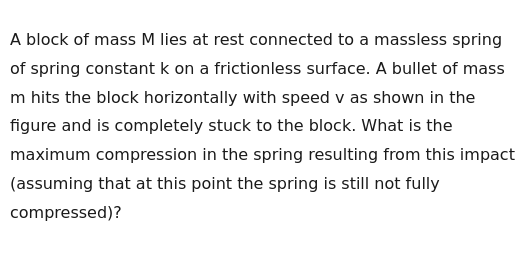Question
Question: A block of mass M lies at rest connected to a massless spring of spring constant k on a frictionles...
A block of mass M lies at rest connected to a massless spring of spring constant k on a frictionless surface. A bullet of mass m hits the block horizontally with speed v as shown in the figure and is completely stuck to the block. What is the maximum compression in the spring resulting from this impact (assuming that at this point the spring is still not fully compressed)?

\frac{mv}{\sqrt{k(M+m)}}
Solution
The problem involves a two-step process:
- An inelastic collision between the bullet and the block.
- The subsequent compression of the spring by the combined mass.
Step 1: Inelastic Collision
Let the mass of the bullet be m and its initial velocity be v. The mass of the block is M, and it is initially at rest. Since the bullet gets stuck to the block, it is a perfectly inelastic collision. Linear momentum is conserved during the collision.
Let V be the velocity of the combined bullet-block system immediately after the collision.
Initial momentum = Final momentum
mv+M(0)=(m+M)V
mv=(m+M)V
V=m+Mmv
Step 2: Compression of the Spring
Immediately after the collision, the combined mass (m+M) moves with velocity V and starts compressing the spring. The surface is frictionless, so mechanical energy is conserved after the collision.
The initial mechanical energy of the combined system (immediately after collision, when the spring is relaxed) is purely kinetic energy:
Ei=21(m+M)V2
As the spring compresses, the kinetic energy is converted into elastic potential energy stored in the spring. At the point of maximum compression, say xmax, the velocity of the combined mass becomes momentarily zero.
The final mechanical energy of the system (at maximum compression) is purely potential energy:
Ef=21kxmax2
By conservation of mechanical energy after the collision:
Ei=Ef
21(m+M)V2=21kxmax2
Substitute the expression for V from Step 1:
21(m+M)(m+Mmv)2=21kxmax2
21(m+M)(m+M)2m2v2=21kxmax2
m+Mm2v2=kxmax2
Solve for xmax:
xmax2=k(m+M)m2v2
xmax=k(m+M)m2v2
xmax=k(m+M)mv
This is the maximum compression in the spring.
Explanation of the solution:
- Use conservation of linear momentum during the inelastic collision to find the velocity of the combined bullet-block system immediately after the collision: V=m+Mmv.
- Use conservation of mechanical energy for the combined system and the spring after the collision. Equate the kinetic energy of the combined system immediately after the collision to the potential energy stored in the spring at maximum compression: 21(m+M)V2=21kxmax2.
- Substitute the expression for V into the energy conservation equation and solve for xmax.
